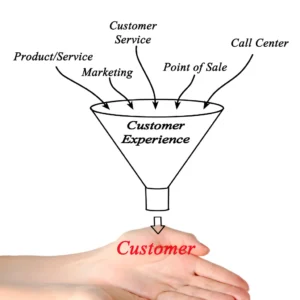
Exploring Retail B2C Industry
AI Tools for Enhanced Product Management and Innovation
Retail B2C Industry AI Tools for Product Management and Innovation have emerged as indispensable assets, empowering retailers to navigate complex consumer trends, optimize product lifecycles, and deliver personalized experiences.
Staying ahead of the curve requires innovative technology-based strategies in today’s rapidly evolving retail landscape.
From market trend analysis to sustainable product recommendations, these advanced tools leverage artificial intelligence to unlock actionable insights, streamline operations, and drive competitive advantage.
This article delves into the multifaceted world of Retail B2C Industry AI Tools, exploring their applications, benefits, challenges, and strategic considerations for successful implementation.
Discover how these transformative technologies reshape retail and propel businesses towards sustainable growth and unparalleled success.
Table of Contents
AI Tool ideas for Enhanced Product Management and Innovation
Market Trend Analysis Tools:
- Incorporate natural language processing (NLP) to analyze social media, reviews, and blogs for sentiment analysis related to product trends.
- Utilize predictive analytics to identify potential trends based on historical data and current market dynamics.
AI-Driven Product Development:
- Implement sentiment analysis on customer feedback to provide insights into potential product improvements.
- Enable machine learning algorithms to recommend modifications or new features based on customer preferences and market trends.
Product Lifecycle Management:
- Integrate IoT sensors and RFID technology for real-time tracking of product distribution in the supply chain.
- Implement blockchain technology for secure and transparent record-keeping throughout the product lifecycle.
Automated Product Tagging:
- Enhance computer vision algorithms by incorporating deep learning techniques for improved accuracy in recognizing and tagging products.
- Implement feedback loops to allow users to correct and improve the tagging system, contributing to continuous learning.
Trend Analysis and Forecasting:
- Include predictive maintenance algorithms to anticipate potential disruptions in the supply chain and address them proactively.
- Implement anomaly detection to identify unusual patterns in sales or inventory, enabling quick responses to unexpected changes.
Sustainable Product Recommendations:
- Integrate carbon footprint calculators to give customers detailed information on the product’s environmental impact.
- Implement supply chain transparency tools to trace the origin of raw materials, ensuring the integrity of sustainability claims.
Collaboration Features:
- Incorporate real-time collaboration features like virtual reality (VR) meeting rooms or augmented reality (AR) tools for enhanced cross-functional team collaboration.
- Integrate project management features to streamline workflows and enhance communication among team members.
Transparent Communication of Product Sustainability:
- Implement blockchain to create an immutable and transparent record of sustainability information, providing consumers with trustworthy data.
- Utilize AI-powered chatbots or virtual assistants to engage with customers, answering queries related to product sustainability in real time.
Business Knowledge Requirements
Understanding Market Dynamics:
Understanding market dynamics is crucial to successfully developing Retail B2C Industry AI Tools for Product Management and Innovation. This involves comprehending consumer behaviour, identifying key competitors, and staying informed about emerging trends and shifts in consumer preferences. This knowledge helps design AI-driven tools that accurately predict and adapt to changing market demands.
Product Lifecycle Knowledge:
A fundamental grasp of the product lifecycle stages is essential. This includes awareness of product introduction, growth, maturity, and decline phases. Understanding how products evolve and interact within these stages allows for developing practical tools for managing and optimizing product lifecycles.
Awareness of Supply Chain Processes:
An in-depth knowledge of supply chain processes is necessary for creating tools that enhance visibility and efficiency. This involves understanding how products move from manufacturing to distribution to the end consumer. Familiarity with inventory management, order fulfilment, and logistics helps integrate AI tools seamlessly into existing supply chain systems.
Product Tagging and Categorization:
Understanding the nuances of product tagging is vital for creating accurate and efficient automated tagging tools. This involves knowledge of product categories and variations and recognizing subtle differences in product attributes. A grasp of catalogue management systems aids in building algorithms that enhance tagging accuracy over time.
Market Research and Trend Analysis:
A solid foundation in market research principles is required to develop practical trend analysis tools. This includes knowledge of data collection methodologies, statistical analysis, and interpretation of market reports. Integration with fashion and design trend databases demands an understanding of the unique dynamics of the retail industry.
Sustainability Awareness:
To implement sustainable product recommendation algorithms, being well-versed in environmental considerations and sustainable practices within the retail industry is essential. This includes knowledge of eco-friendly materials, supply chain transparency, and communicating product sustainability information transparently.
Cross-Functional Collaboration Skills:
Understanding the importance of cross-functional collaboration within retail organizations is critical. This involves knowing how different marketing, design, and logistics departments operate and interact. Developing collaboration features requires insights into effective communication and project management practices to facilitate seamless teamwork.
Technical Knowledge Requirements
Programming Languages and Frameworks:
To create AI Tools for Product Management and Innovation in the Retail B2C industry, proficiency in programming languages like Python and R is essential. Familiarity with relevant frameworks like TensorFlow and PyTorch for machine learning and Django or Flask for web development is vital for building robust analytics tools.
Database Management:
A solid understanding of database management is necessary for handling and analyzing large sets of retail data. Knowledge of SQL for relational databases and NoSQL databases like MongoDB is essential. Mastery in querying and manipulating data allows for effectively extracting insights for reporting purposes.
Data Visualization Tools:
Proficiency in data visualization tools in Python, such as Tableau, Power BI, Matplotlib, and Seaborn, is essential. These tools enable the creation of visually compelling reports and dashboards, translating complex analytics into understandable and actionable insights for stakeholders.
Big Data Technologies:
Knowledge of big data technologies becomes imperative in scenarios where the retail dataset is extensive. Apache Hadoop and Apache Spark are popular tools for efficiently processing and analyzing large datasets. Understanding distributed computing concepts is crucial for optimizing performance in handling vast retail data.
Cloud Platforms:
Experience with cloud platforms like AWS, Azure, or Google Cloud is essential for developing scalable and accessible analytics tools. Cloud services provide the infrastructure for storing, processing, and analyzing data, ensuring flexibility and cost-effectiveness in deploying AI solutions for retail analytics.
Machine Learning Models and Algorithms:
It’s essential to comprehend the various machine learning models and algorithms thoroughly. This includes knowledge of regression models, clustering algorithms, and neural networks. Familiarity with pre-trained models for computer vision in the context of automated product tagging is vital for accurate and efficient tagging solutions.
Integration with External APIs:
To incorporate real-time updates on emerging trends or sustainability data, the ability to integrate with external APIs is essential. This requires knowledge of API protocols, such as REST or GraphQL, and the capability to securely fetch and update data from external sources in real time.
Mobile and Web Development:
If the analytics and reporting tools are intended for various devices, including mobile and web platforms, proficiency in mobile development (using languages like Swift or Kotlin) and web development (HTML, CSS, JavaScript) is necessary. Responsive design principles ensure that the analytics tools function seamlessly across different devices.
Current AI Tools and Technologies available for Product Management and Innovation
1. Market Trend Analysis Tools:
- Google Trends and Analytics: Google provides powerful tools for analyzing market trends. Google Trends helps identify search interest over time, while Google Analytics provides insights into website traffic, user behaviour, and conversion metrics. Integrating these tools can enhance understanding of online consumer behaviour and market trends.
- SEMrush: SEMrush is an all-in-one toolkit for marketing that allows businesses to analyze their online visibility. It provides data on keyword trends, competitor strategies, and backlink analysis, contributing valuable information for market trend analysis.
2. AI-Driven Product Development:
- IBM Watson Studio: IBM Watson Studio is a comprehensive platform that facilitates AI and machine learning development. It provides tools for data preparation, model development, and deployment. Integration with product databases and market research data can be streamlined using Watson Studio to enhance AI-driven product development.
- Azure Machine Learning Studio: Microsoft’s Azure Machine Learning Studio is a user-friendly platform for building, testing, and deploying machine learning models. It supports integration with various data sources and facilitates collaboration among cross-functional teams, which is essential for product development and Innovation.
3. Product Lifecycle Management:
- PTC Windchill: PTC Windchill is a product lifecycle management (PLM) solution that aids in managing product data throughout its lifecycle. It integrates with inventory and sales systems, providing a unified platform for cross-functional teams to collaborate on product-related tasks.
- Siemens Teamcenter: Siemens Teamcenter is a Product Lifecycle Management (PLM) solution that helps organizations efficiently manage product information and collaborate easily. It supports integrating product data with other enterprise systems, fostering seamless product lifecycle management.
4. Automated Product Tagging:
- Google Cloud Vision API: Google Cloud Vision API offers advanced computer vision capabilities for image analysis. It can be utilized for automated product tagging, utilizing machine learning algorithms to accurately identify and categorize products based on images.
- Amazon Rekognition: Amazon Rekognition is a deep learning-based image and video analysis service. It can be integrated into retail systems for automated product tagging, leveraging its object recognition and content analysis capabilities.
5. Trend Analysis and Forecasting:
- Tableau: Tableau is a robust tool that provides data visualization capabilities, helping with trend analysis. It can connect to various data sources, including machine learning models, and present insights in an easily understandable format, facilitating data-driven decision-making.
- SAS Forecast Studio: SAS Forecast Studio is a specialized time series analysis and forecasting tool. It can be integrated with market data and machine learning models to predict emerging trends accurately.
6. Sustainable Product Recommendations:
- Ecolabel Index: The Ecolabel Index is an ecological and sustainability standards database. Integrating this data into retail systems can aid in suggesting environmentally friendly products based on recognized certifications and sustainability criteria.
- IBM Sterling Supply Chain Suite: The IBM Sterling Supply Chain Suite incorporates AI to enhance supply chain visibility, allowing for the integration of sustainability databases. This enables the transparent communication of product sustainability information throughout the supply chain.
Technical Integrations Requirements
1. Enterprise Resource Planning (ERP) Integration:
- Objective: Integrate with ERP systems to streamline business processes, enhance data accuracy, and provide a unified platform for managing product-related information.
- Implementation: Connect the AI tools with ERP systems like SAP, Oracle, or Microsoft Dynamics. This integration ensures seamless communication between product management tools and the broader business environment, incorporating sales, inventory, and financial data.
2. Customer Relationship Management (CRM) Integration:
- Objective: Facilitate a holistic view of customer interactions and preferences, allowing for personalized product recommendations and improved customer satisfaction.
- Implementation: Integrate with CRM systems such as Salesforce or HubSpot. By synchronizing customer data, AI tools can offer insights into customer behaviour, helping retailers tailor their product strategies to meet specific customer needs.
3. E-commerce Platform Integration:
- Objective: Ensure a smooth data flow between the AI tools and e-commerce platforms, optimize online product listings, and enhance the overall customer shopping experience.
- Implementation: Connect with popular e-commerce platforms like Shopify, Magento, or WooCommerce. This integration enables real-time product availability, pricing, and trend updates, ensuring that online platforms reflect the most accurate and relevant information.
4. Supply Chain Management Integration:
- Objective: Enhance supply chain visibility and coordination by integrating AI tools with supply chain management systems, optimizing inventory levels, and reducing disruptions.
- Implementation: Connect with supply chain management platforms such as Blue Yonder, Kinaxis, or Manhattan Associates. This integration ensures that the AI tools have real-time access to supply chain data, enabling proactive decision-making based on current market trends and inventory levels.
5. Content Management System (CMS) Integration:
- Objective: Streamline updating product information and maintaining consistency across various channels by integrating with content management systems.
- Implementation: Connect with CMS platforms like WordPress, Drupal, or Adobe Experience Manager. This integration ensures that product information, including images, descriptions, and tags, is consistently updated across all channels, maintaining accuracy and coherence.
6. IoT and RFID Integration:
- Objective: Enhance product tracking and monitoring capabilities by integrating IoT sensors and RFID technology, providing real-time visibility into product movements.
- Implementation: Connect with IoT platforms such as Microsoft Azure IoT or AWS IoT. This integration allows the AI tools to receive data from connected devices, enabling precise tracking of products throughout the supply chain and enhancing overall visibility.
7. Data Analytics and Business Intelligence Integration:
- Objective: Further optimize decision-making processes by integrating data analytics and business intelligence tools, allowing for more in-depth analysis and reporting.
- Implementation: Connect with Tableau, Power BI, or Google Analytics analytics platforms. This integration enables AI tools to leverage advanced analytics for deeper insights into market trends, customer behaviour, and product performance.
Training Needs for Staff Managing on AI Tools for Product Management and Innovation
1. Understanding AI Concepts:
- Objective: Provide staff with a foundational understanding of AI concepts, including machine learning, deep learning, and natural language processing, to ensure they grasp the underlying principles of the Retail B2C Industry AI Tools.
- Training Approach: Conduct workshops and sessions explaining basic AI concepts, emphasizing how the tools leverage these technologies. Online courses, seminars, or guest lectures from AI experts can also contribute to building a solid foundation.
2. Tool-Specific Training:
- Objective: Familiarize staff with the specific Retail B2C Industry AI Tools for Product Management and Innovation, ensuring they can navigate the interfaces, interpret results, and utilize advanced features effectively.
- Training Approach: Provide hands-on training sessions with the actual tools, allowing staff to interact and experiment in a controlled environment. Develop comprehensive training manuals, video tutorials, and documentation for reference.
3. Data Management and Quality Control:
- Objective: It’s crucial to provide your staff with comprehensive training on data management best practices. They need to understand the significance of maintaining data quality, consistency, and security to ensure the success of your business. By investing in their training, you can empower them to handle data efficiently and effectively, leading to better decision-making and improved organizational performance. This ensures that the AI tools receive accurate and reliable input for optimal performance.
- Training Approach: Equip your team with the essential skills they need to handle data like pros. Schedule training sessions that cover everything from data preprocessing to cleaning and validation. Your team will learn practical techniques they can apply right away to ensure your data is always accurate and reliable. Emphasize the significance of maintaining data integrity throughout the product lifecycle. Implement periodic refresher courses to address evolving data management practices.
4. Interpretation of AI Insights:
- Objective: Equip staff with the skills to interpret and act upon the insights generated by the AI tools. This involves understanding analytics, interpreting trend reports, and making data-driven decisions.
- Training Approach: Develop training modules that focus on interpreting AI-generated insights, emphasizing actionable steps based on the analytics. Use real-world examples to illustrate how insights influence product management and innovation strategies.
5. Cross-Functional Collaboration:
- Objective: Foster collaboration among cross-functional teams, ensuring seamless communication between different departments. This is crucial for leveraging the collaborative features of the AI tools effectively.
- Training Approach: Organize team-building exercises, workshops, or seminars emphasizing effective communication and collaboration. Encourage staff to understand the roles of different departments and how their contributions collectively impact product management and Innovation.
6. Security and Compliance Training:
- Objective: Educate staff on data security, privacy, and compliance with industry regulations. Ensuring employees understand their responsibility in maintaining the security and integrity of AI-generated data is crucial.
- Training Approach: Provide specialized training on data protection, cybersecurity, and compliance with relevant industry standards. Regularly update staff on changes in regulations to ensure ongoing adherence.
7. Continuous Learning and Adaptation:
- Objective: Cultivate a culture of continuous learning to keep staff abreast of emerging AI trends, industry developments, and updates to the Retail B2C Industry AI Tools.
- Training Approach: Establish a learning platform or knowledge-sharing sessions where staff can stay updated on AI advancements, attend webinars, and participate in relevant conferences. Encourage certifications to validate and expand their AI skill set.

Arindam Roy
An Automation Consultant with 25+ years of IT Experience
Challenges and Workarounds on AI Tools for Product Management and Innovation
Data Quality and Availability
Challenge:
The effectiveness of Retail B2C Industry AI Tools heavily relies on the quality and availability of data. Only accurate or complete data can lead to biased insights and hinder the tools’ ability to provide meaningful recommendations.
Workaround:
Implement robust data quality control measures, including regular audits, data cleansing, and validation. Utilize data augmentation techniques to enhance datasets and collaborate with departments to ensure consistent and accurate data entry.
Integration Complexity
Challenge:
Integrating AI tools with existing systems such as ERP, CRM, and e-commerce platforms can be complex, requiring compatibility and seamless data flow.
Workaround:
Engage with experienced integration specialists to ensure a smooth integration process. Use standardized APIs to simplify communication between systems. Conduct thorough testing during the integration phase to identify and address any compatibility issues.
Employee Resistance to AI Adoption
Challenge:
Employees may resist adopting AI tools due to fear of job displacement, lack of understanding, or discomfort with technology.
Workaround:
Implement a comprehensive change management strategy that includes education and training programs to alleviate fears and demonstrate the benefits of AI adoption. Encourage an inclusive approach, involving employees in the decision-making process and emphasizing the augmentation of their roles through AI.
Interpretability of AI Insights
Challenge:
Understanding and interpreting complex AI-generated insights can be challenging for non-technical staff, leading to potential misinterpretations.
Workaround:
Develop user-friendly interfaces and visualizations that simplify the presentation of insights. Offer training sessions focused on interpreting AI-generated reports and insights, providing practical examples to enhance understanding.
Security Concerns
Challenge:
Data security and privacy concerns arise when integrating AI tools, especially when handling sensitive customer information.
Workaround:
Implement robust cybersecurity measures, encryption protocols, and access controls to safeguard data. Complying with data protection regulations and updating security protocols regularly to address emerging threats is critical.
Continuous Learning and Adaptation
Challenge:
The rapidly evolving nature of AI technology requires continuous learning, which may pose challenges for existing staff.
Workaround:
Establish a dedicated learning culture within the organization, providing employees with ongoing education and certification resources. It is recommended that individuals attend industry conferences and workshops to stay up-to-date with the latest advancements in AI.
Cost and Resource Allocation
Challenge:
Developing and maintaining AI tools can be resource-intensive, requiring financial investment and skilled personnel.
Workaround:
Conduct a thorough cost-benefit analysis to justify the investment in AI tools. Consider leveraging cloud services to reduce infrastructure costs and explore collaboration with AI service providers to access specialized expertise without hiring a large in-house team.
Ethical and Bias Concerns
Challenge:
AI tools may inadvertently introduce biases, impact decision-making and potentially lead to ethical concerns.
Workaround:
Implement ethical AI guidelines, conduct regular audits to identify and address biases, and involve diverse teams in developing and decision-making processes to ensure a more comprehensive perspective.
Cost and Benefits of AI Tools designed for Product Management and Innovation
Development Costs:
- Investment in Technology and Infrastructure: Developing sophisticated AI tools requires significant investment in technology, including advanced algorithms, machine learning models, and the underlying infrastructure. Costs may include acquiring powerful hardware, software licenses, and specialized development tools.
- Skilled Personnel: Hiring skilled AI developers, data scientists, and domain experts is essential. Their expertise is crucial for designing, building, and fine-tuning AI tools tailored to the specific needs of the retail B2C industry.
Integration Costs:
- Integration with Existing Systems: Integrating AI tools with existing systems, such as ERP, CRM, and e-commerce platforms, incurs costs for ensuring seamless communication and data flow between different organization components.
- Middleware and API Costs: Implementing middleware and APIs to facilitate data exchange between disparate systems may involve additional licensing or development costs.
Training and Education:
- Employee Training: Training existing staff to effectively use and manage AI tools is a crucial investment. Costs may include organizing workshops, hiring external trainers, and developing comprehensive training materials.
- Continuous Learning Programs: Establishing programs for constant learning and skill development is an ongoing cost to keep the workforce updated on emerging AI trends and technologies.
Maintenance and Upkeep:
- Software Maintenance: Ongoing maintenance of AI tools, including software updates, bug fixes, and improvements, is a continuous cost. This ensures the tools remain relevant, secure, and aligned with evolving business requirements.
- Infrastructure and Cloud Service Costs: Cloud service fees can be recurring for hosting and processing data. Monitoring and optimizing cloud infrastructure to manage costs efficiently are essential considerations.
Benefits of Creating and Using Retail B2C Industry AI Tools:
- Enhanced Decision-Making: AI tools provide data-driven insights that empower retailers to make informed decisions. This includes identifying market trends, optimizing product lifecycles, and responding promptly to changes in customer preferences.
- Improved Operational Efficiency: Automating tasks, such as product tagging and trend analysis, streamlines operations, reducing manual effort and errors. This leads to improved efficiency in managing product lifecycles and supply chains.
- Enhanced Customer Experience: AI-driven tools enable retailers to offer personalized product recommendations, improving the overall customer experience. It is crucial to understand their preferences and adjust product strategies accordingly thoroughly. This requires a clear and concise communication of information, using simple and direct language that leaves no room for ambiguity. Prioritizing the most critical data at the beginning is crucial to ensure a clear and logical information organization. Using active voice, plain language, and short sentences will help communicate the message forcefully and assertively. The audience’s needs should be prioritized using simple language to increase customer satisfaction and loyalty.
- Increased Sales and Revenue: Targeted product recommendations based on AI insights can drive sales by presenting customers with products aligned with their preferences. Optimizing product management and Innovation can lead to increased revenue streams.
- Competitive Advantage: Retailers gain a competitive edge by adopting AI tools that help them stay ahead of market trends, manage products efficiently, and swiftly respond to changing consumer behaviours. This positions them as leaders in the dynamic retail landscape.
- Cost Savings in the Long Run: The initial investment is substantial, but the long-term benefits of reduced operational costs, improved efficiency, and increased revenue can outweigh the upfront expenditures.
- Scalability and Flexibility: AI tools are scalable and adaptable, allowing retailers to grow and adjust their strategies according to market demands. This scalability contributes to future-proofing the business.
- Sustainable Practices: AI tools can aid in incorporating sustainable practices by recommending environmentally friendly products, tracking supply chain sustainability, and providing transparent information to consumers.
Conclusion
In conclusion, venturing into the Retail B2C Industry AI Tools for Product Management and Innovation realm represents a transformative journey with challenges and opportunities. The comprehensive toolset discussed, from market trend analysis to sustainable product recommendations, offers a robust framework for retailers to navigate the complexities of today’s dynamic consumer landscape.
The technical intricacies of building these AI tools necessitate a solid understanding of programming languages, database management, data visualization, and integration with existing systems. Embracing available technologies, such as Google Trends, IBM Watson Studio, and Amazon Rekognition, provides a foundation for creating advanced solutions that cater to the evolving needs of the retail B2C sector.
However, implementing these tools comes with a set of challenges. Strategic addressing of data quality, integration complexities, employee resistance, and the interpretability of AI insights is necessary. A proactive approach, which includes comprehensive training programs, ethical guidelines, and a focus on fostering a culture of continuous learning, can help overcome challenges and ensure successful implementation.
The cost-benefit analysis further underscores the strategic considerations involved in adopting AI tools. While the initial investment in development, integration, and training is substantial, the potential benefits of enhanced decision-making, operational efficiency, improved customer experience, increased sales, and a sustainable competitive advantage can yield significant returns over time.
As the retail industry evolves, adopting AI tools for retail B2C becomes a strategic imperative rather than a choice. It’s a journey that requires a delicate balance between technological Innovation, human adaptation, and a commitment to ethical and sustainable practices. In this fusion of cutting-edge technology and retail acumen, the path forward holds immense potential for those willing to navigate the challenges and harness the transformative power of AI in product management and Innovation.
Related Articles
- AI Automation Tools in Brick-and-Mortar Retail Store
- AI Tools for Retail B2C Industry
- AI Tools for Customer Feedback and Support in Retail B2C
- AI Tools for Marketing and Advertising in Retail B2C Industry
- AI Tools for Fraud Prevention and Security in Retail B2C
- AI Tools for Sales and Conversion Optimization in the Retail B2C
- AI Tools for Customer Loyalty and Retention in Retail B2C
- AI Tools for Analytics and Reporting in Retail B2C Industry
- AI Tools for Supply Chain Visibility and Optimization in Retail
- AI Tools for Customer Experience and Engagement in Retail
- AI Tools for Inventory and Supply Chain Management for Retail
- AI in Retail Customer Experience
























